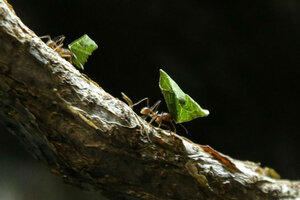The world's first known farmers weren't humans, but Fijian ants
Fijian ants have been farming plants for three million years, new research from the University of Munich suggests. The ants depend on these plants to provide them with shelter.

A pair of Texas leaf cutter ants carry leaves down a branch in a display at the Houston Zoo's bug house in 2014. Researchers at the University of Munich have found that Fijian ants may have been the first farmers.
Pat Sullivan/AP/File
Three million years ago, the first farmers began carefully sowing seeds, fertilizing them, and waiting for them to grow into plants. These first farmers, new research suggests, were Fijian ants.
Guillaume Chomicki and Susanne Renner, two researchers at the University of Munich, observed the Fijian ant species Philidris nagasau for their recent study in Nature Plants. They knew that the ants live in the hollow structures, called domatia, of Squamellaria plants. But by watching the ants, they discovered that the ants also sow and nurture the plants.
It’s one of several known examples of a symbiotic relationship between ants and plants. But in this case, the ants are dependent on the plants for shelter, while the plants rely on the ants to sow their seeds.
“The story is unique,” Brian Fisher, entomologist-in-residence at the California Academy of Sciences, told NPR. “We already have ants that disperse seeds, and have ants that feed plants, but we've never had a case where they farm a plant they can't live without."
Many other types of ants work in tandem with other species. Leafcutter ants, for instance, have been farming fungus for at least eight million years. A fossilized Acropyga ant indicates that the species has been farming mealybugs for between 15 and 20 million years. Dozens of ant species sow plant seeds, while approximately 700 types of plants shelter ants in their domatia.
But P. nagasau and Squamellaria are the only animal-plant pair to be dependent on one another for their survival.
Squamellaria is an epiphyte, meaning that it grows on other plants. Worker ants carry the Squamellaria seeds from the fully-grown plants to other trees, selecting trees that have soft bark — making it easy to plant the seeds — or produce nectar. The ants embed seeds in their six preferred species of tree.
The ants then monitor the planted seeds to keep herbivores away. As the plants grow, they develop hollow domatia on the base of their stems, and the ants fertilize the plants to encourage further growth. Once the domatia are big enough, the ants move in. They can eat the fruit of the Squamellaria plant and harvest the seeds for future plantings.
It’s not yet clear what created the early symbiosis between ants and plants in Fiji. But it put them millions of years ahead of humans, who only began sowing and collecting seeds around 12,000 years ago, say researchers.

